Wireless Energy Harvesting with Cooperative Relaying under the Best Relay Selection Scheme
Abstract
1. Introduction
- (i)
- Analysis of the outage probability (OP) for AF-EH relaying under best relay selection (BRS) scheme with SWIPT technique, by computing the OP for the direct path and the OP for the best relay path. The EH relay can be more valuable over small areas. Consequently, the proposed system is considered in which the source, relays and destination are located in a small territory. In this case, outage probability will be beneficial due to the restrictions decreed on the relays by the energy constraints.
- (ii)
- Investigation of the performance of total consumed energy for AF wireless energy harvesting (WEH) relaying under BRS scheme, by minimizing the total EC to improve EE for EH relaying over conventional relaying.
- (iii)
- Derivation of the energy efficiency (EE) for AF-EH relaying, taking into account the outage probability factor and compare the results with conventional cooperative relaying with a different number of relays. Also, the effect of the power-splitting ratio on the EE is applied and the steady-state convergence is shown for different values of the power-splitting ratio.
- (iv)
- The SE-EE trade-off is analysed for both conventional and EH relays, with the aim of optimizing the total energy consumption, by illustrating the design of the wireless networks that consider only SE and the design of the wireless networks that consider only EE. The SE-EE metric is useful in the design of required wireless EH networks to quantify the desired SE and EE.
2. Related Works
3. System Model
3.1. Cooperative Energy Harvesting
3.2. Moment Generating Function (MGF) and Probability Density Function (PDF) of BRS in EH Relaying
3.3. Energy Status in EH Relaying
4. Performance Analysis
4.1. Spectral Efficiency (SE)
4.2. Outage Probability (OP)
4.3. Energy Consumption (EC) for EH Relaying
4.4. Energy Efficiency for EH Relaying
| Algorithm 1: EE for EH Relaying. |
|
5. Numerical Results
6. Conclusions
Author Contributions
Funding
Acknowledgments
Conflicts of Interest
Abbreviations
| 5G | Fifth Generation |
| RF | Radio-Frequency |
| AWGN | Additive White Gaussian Noise |
| 3GPP | Third Generation Partnership Project |
| EH | Energy Harvesting |
| BRS | Best Relay Selection |
| CR | Cooperative Relaying |
| EC | Energy Consumption |
| EE | Energy Efficiency |
| SE | Spectral Efficiency |
| SNR | Signal to Noise Ratio |
| AF | Amplify-and-Forward |
| DF | Decode-and-Forward |
| SWIPT | Simultaneous Wireless Information and Power Transfer |
| GSM | Global System for Mobile |
| LTE | Long Term Evolution |
| LTE-A | Long Term Evolution-Advanced |
| OP | Outage Probability |
| PS | Power Splitting |
| TS | Time Switching |
| MOP | Multi-Objective Optimisation problem |
| SOP | Single-Objective Optimisation problem |
| IOT | Internet of things |
| MSR | Multicast Secrecy Rate |
| WPT | Wireless Power Transfer |
| WPCNs | Wireless Powered Communication Networks |
| ICT | Information and Communication Technolog |
| PFUF | Proportional Fairness Utility Function |
| SC | Selection Combining |
| MRC | Maximal Ratio Combining |
| MAC | Multiple Access Channel |
| PAC | Parallel Access Channel |
| CMAC | Cooperative MAC |
| CPAC | Cooperative PAC |
| DFC | Decision Fusion Center |
| DaF | Decode-and-Fuse |
| DtF | Decode-then-Fuse |
| CJ | Cooperative Jamming |
| ARP | All Relay Participate |
| GA | Genetic Algorithm |
| CSI | Channel State Information |
Appendix A. Derivation of Outage Probability
Appendix B. Derivation of e2e SNR
References
- Boyer, J.; Falconer, D.D.; Yanikomeroglu, H. Multihop diversity in wireless relaying channels. IEEE Trans. Commun. 2004, 52, 1820–1830. [Google Scholar] [CrossRef]
- Halima, N.; Boujemaa, H. Exact and Approximate Symbol Error Probability of cooperative systems with best relay selection and all participating relaying using Amplify and Forward or Decode and Forward Relaying over Nakagami-m fading channels. KSII Trans. Internet Inf. Syst. 2018, 12, 81–108. [Google Scholar] [CrossRef]
- Andrawes, A.; Nordin, R. Survey on performance of Adaptive Modulation scheme with cooperative Diversity in wireless systems. In Proceedings of the 2015 1st International Conference on Telematics and Future Generation Networks (TAFGEN), Kuala Lumpur, Malaysia, 26–28 May 2015; pp. 65–70. [Google Scholar] [CrossRef]
- Georgy, L.; Sergey, L. Amplify-and-forward versus decode-and-forward relaying: Which is better? In Proceedings of the 22th International Zurich Seminar on Communications (IZS), Zurich, Switzerland, 29 February–2 March 2012. [Google Scholar]
- Touati, S.; Boujemaa, H.; Abed, N. Static hybrid multihop relaying and two hops hybrid relaying using DSTC. Ann. Telecommun. 2014, 70, 171–180. [Google Scholar] [CrossRef]
- Tseng, S.; Liao, C. Distributed orthogonal and quasi-orthogonal space-time block code with embedded AAF/DAF matrix elements in wireless relay networks with four relays. Wirel. Pers. Commun. 2013, 75, 1178–1198. [Google Scholar] [CrossRef]
- Zhang, R.; Ho, C.K. MIMO broadcasting for simultaneous wireless information and power transfer. IEEE Trans. Wirel. Commun. 2013, 12, 1989–2001. [Google Scholar] [CrossRef]
- Zhou, X.; Zhang, R.; Ho, C.K. Wireless information and power transfer: Architecture design and rate-energy tradeoff. IEEE Trans. Commun. 2013, 61, 4754–4767. [Google Scholar] [CrossRef]
- Li, C.; Song, S.H.; Zhang, J.; Letaief, K.B. Maximizing energy efficiency in wireless networks with a minimum average throughput requirement. In Proceedings of the 2012 IEEE Wireless Communications and Networking Conference (WCNC), Shanghai, China, 1–4 April 2012; pp. 1130–1134. [Google Scholar] [CrossRef]
- Alsharif, M.H.; Nordin, R.; Ismail, M. Survey of green radio communications networks: Techniques and recent advances. J. Comput. Netw. Commun. 2013, 2013, 1–13. [Google Scholar] [CrossRef]
- Huang, J.; Xing, C.; Wang, C. Simultaneous wireless information and power transfer: Technologies, applications, and research challenges. IEEE Commun. Mag. 2017, 55. [Google Scholar] [CrossRef]
- Luo, S.; Zhang, R.; Lim, T.J. Optimal save-then-transmit protocol for energy harvesting wireless transmitters. IEEE Trans. Wirel. Commun. 2013, 12, 1196–1207. [Google Scholar] [CrossRef]
- Miao, G.; Song, G. Energy and Spectrum Efficient Wireless Network Design, 1st ed.; Cambridge University Press: Cambridge, UK, 2014. [Google Scholar] [CrossRef]
- Liu, L.; Zhang, R.; Chua, K.C. Wireless information and power transfer: A dynamic power splitting approach. IEEE Trans. Commun. 2013, 61, 3990–4001. [Google Scholar] [CrossRef]
- Pervaiz, H.B.; Musavian, L.; Ni, Q.; Ding, Z. Energy and spectrum efficient transmission techniques under QoS constraints toward green heterogeneous networks. IEEE Access 2015, 17, 1655–1671. [Google Scholar] [CrossRef]
- Fan, R.; Atapattu, S.; Chen, W.; Zhang, Y.; Evans, J. Throughput maximization for multi-hop decode- and-forward relay network with wireless energy harvesting. IEEE Access 2018, 6, 24582–24595. [Google Scholar] [CrossRef]
- Gao, H.; Ejaz, W.; Jo, M. Cooperative wireless energy harvesting and spectrum sharing in 5G networks. IEEE Access 2016, 4, 3647–3658. [Google Scholar] [CrossRef]
- Ahmed, I.; Ikhlef, A.; Schober, R.; Mallik, R.K. Joint power allocation and relay selection in energy harvesting AF relay systems. IEEE Wirel. Commun. Lett. 2013, 2, 239–242. [Google Scholar] [CrossRef]
- Deng, Z.; Gao, Y.; Cai, C.; Li, W. Optimal transceiver design for SWIPT system with full-duplex receiver and energy-harvesting eavesdropper. Phys. Commun. 2018, 26, 1–8. [Google Scholar] [CrossRef]
- Lee, J.H.; Sohn, I.; Kim, Y.H. Simultaneous wireless power transfer and secure multicasting in cooperative decode-and-forward relay networks. Sensors 2017, 17, 1128. [Google Scholar] [CrossRef] [PubMed]
- Zhang, J.; Zhou, Q.; Ng, D.W.; Jo, M. Optimal energy efficiency fairness of nodes in wireless powered communication networks. Sensors 2017, 17, 2125. [Google Scholar] [CrossRef] [PubMed]
- Rabie, K.; Salem, A.; Alsusa, E.; Alouini, M. Energy-harvesting in cooperative AF relaying networks over log-normal fading channels. In Proceedings of the 2016 IEEE International Conference on Communications (ICC), Kuala Lumpur, Malaysia, 22–27 May 2016. [Google Scholar] [CrossRef]
- Zhang, Z.; Li, Y.; Huang, K.; Liang, C. Energy efficiency analysis of energy harvesting relay-aided cooperative networks. In Proceedings of the 2015 13th International Symposium on Modeling and Optimization in Mobile, Ad Hoc, and Wireless Networks (WiOpt), Mumbai, India, 25–29 May 2015. [Google Scholar] [CrossRef]
- Zhang, Q.; Jia, J.; Zhang, J. Cooperative relay to improve diversity in cognitive radio networks. IEEE Commun. Mag. 2009, 47, 111–117. [Google Scholar] [CrossRef]
- Suraweera, H.; Smith, P.; Armstrong, J. Outage probability of cooperative relay networks in Nakagami-m fading channels. IEEE Commun. Lett. 2006, 10, 834–836. [Google Scholar] [CrossRef]
- Adinoyi, A.; Yanikomeroglu, H. Cooperative relaying in multi-antenna fixed relay networks. IEEE Trans. Wirel. Commun. 2007, 6, 533–544. [Google Scholar] [CrossRef]
- Bhatnagar, M. On the capacity of decode-and-forward relaying over rician fading channels. IEEE Commun. Lett. 2013, 17, 1100–1103. [Google Scholar] [CrossRef]
- Salvo, P.; Ciuonzo, D.; Romano, G. Orthogonality and cooperation in collaborative spectrum sensing through MIMO decision fusion. IEEE Trans. Wirel. Commun. 2013, 12, 5826–5836. [Google Scholar] [CrossRef]
- Ciuonzo, D.; Romano, G.; Rossi, P. Channel-aware decision fusion in distributed MIMO wireless sensor networks: Decode-and-Fuse vs. Decode-then-Fuse. IEEE Trans. Wirel. Commun. 2012, 11, 2976–2985. [Google Scholar] [CrossRef]
- Ciuonzo, D.; Rossi, P.; Dey, S. Massive MIMO channel-aware decision fusion. IEEE Trans. Signal Process. 2015, 63, 604–619. [Google Scholar] [CrossRef]
- Li, J.; Petropulu, A.; Weber, S. On cooperative relaying schemes for wireless physical layer security. IEEE Trans. Signal Process. 2011, 59, 4985–4997. [Google Scholar] [CrossRef]
- Andrawes, A.; Nordin, R.; Ismail, M. Energy harvesting with cooperative networks and adaptive transmission. In Proceedings of the 2017 IEEE Jordan Conference on Applied Electrical Engineering and Computing Technologies (AEECT), Aqaba, Jordan, 11–13 October 2017. [Google Scholar] [CrossRef]
- Jiang, D.; Zhang, P.; Lv, Z.; Song, H. Energy-efficient multi-constraint routing algorithm with load balancing for smart city applications. IEEE Internet Things J. 2016, 3, 1437–1447. [Google Scholar] [CrossRef]
- Lubritto, C.; Petraglia, A.; Vetromile, C.; Curcuruto, S.; Logorelli, M.; Marsico, G.; D’Onofrio, A. Energy and environmental aspects of mobile communication systems. Energy 2011, 36, 1109–1114. [Google Scholar] [CrossRef]
- Kwon, H.; Birdsall, T. Channel capacity in bits per joule. IEEE J. Ocean. Eng. 1986, 11, 97–99. [Google Scholar] [CrossRef]
- Chen, Y.; Zhang, S.; Xu, S.; Li, G.Y. Fundamental tradeoffs on green wireless networks. IEEE Commun. Mag. 2011, 49. [Google Scholar] [CrossRef]
- Chih-Lin, I.; Rowell, C.; Han, S.; Xu, Z.; Li, G.; Pan, Z. Toward green and soft: A 5G perspective. IEEE Commun. Mag. 2014, 52, 66–73. [Google Scholar] [CrossRef]
- Pan, C.; Xu, W.; Wang, J.; Ren, H.; Zhang, W.; Huang, N.; Chen, M. Totally distributed energy-efficient transmission in MIMO interference channels. IEEE Trans. Wirel. Commun. 2015, 14, 6325–6338. [Google Scholar] [CrossRef]
- Miao, G.; Himayat, N.; Li, Y.; Swami, A. Cross-layer optimization for energy-efficient wireless communications: A survey. Wirel. Commun. Mob. Comput. 2009, 9, 529–542. [Google Scholar] [CrossRef]
- Andrawes, A.; Nordin, R.; Ismail, M. Wireless Energy Harvesting with Amplify-andForward Relaying and Link Adaptation under Imperfect Feedback Channel. J. Telecommun. Electron. Comput. Eng. 2018, 10, 83–90. [Google Scholar]
- Andrawes, A.; Nordin, R.; Ismail, M. Energy harvesting with link adaptation under different wireless relaying schemes. J. Commun. 2018, 13, 1–6. [Google Scholar] [CrossRef]
- Alsharif, M.H.; Nordin, R.; Ismail, M. Intelligent cooperation management of multi-radio access technology towards the green cellular networks for the twenty-twenty information society. Telecommun. Syst. 2017, 65, 497–510. [Google Scholar] [CrossRef]
- Liu, Y. Wireless information and power transfer for multi-relay assisted cooperative communication. IEEE Commun. Lett. 2015, 20, 784–787. [Google Scholar] [CrossRef]
- Sesia, S.; Toufik, I.; Baker, M. LTE—UMTS Long Term Evolution from Theory to Practice, 2nd ed.; John Wiley and Sons: New York, NY, USA, 2011. [Google Scholar] [CrossRef]
- Andrawes, A. Performance of adaptive modulation with generalized selection combining in different practical scenarios. In Proceedings of the Seventh International Conference on Computer Engineering and Systems (ICCES), Cairo, Egypt, 27–29 November 2012; pp. 233–337. [Google Scholar] [CrossRef]
- Simon, M.K.; Alouini, M.-S. Digital Communication over Fading Channels; John Wiley and Sons: New York, NY, USA, 2000. [Google Scholar] [CrossRef]
- Avestimehr, A.S.; Tse, D.N.C. Outage capacity of the fading relay channel in the low-SNR regime. IEEE Trans. Inform. Theory 2007, 53, 1401–1415. [Google Scholar] [CrossRef]
- Di, X.; Xiong, K.; Zhang, Y.; Qiu, Z. simultaneous wireless information and power transfer in two-hop OFDM decode-and-forward relay networks. TIIS 2016, 10, 152–167. [Google Scholar] [CrossRef]
- Guo, S.; Zhou, X. Energy-efficient design in RF energy harvesting relay networks. In Proceedings of the 2015 IEEE Global Communications Conference (GLOBECOM), San Diego, CA, USA, 6–10 December 2015. [Google Scholar] [CrossRef]
- Deng, L.; Rui, Y.; Cheng, P.; Zhang, J.; Zhang, Q.T.; Li, M. A unified energy efficiency and spectral efficiency tradeoff metric in wireless networks. IEEE Commun. Lett. 2013, 17, 55–58. [Google Scholar] [CrossRef]
- Gradshteyn, I.S.; Ryzhik, I.M. Table of Integrals, Series, and Products, 7th ed.; Academic Press: San Diego, CA, USA, 2007; ISBN 9780471317791. [Google Scholar]
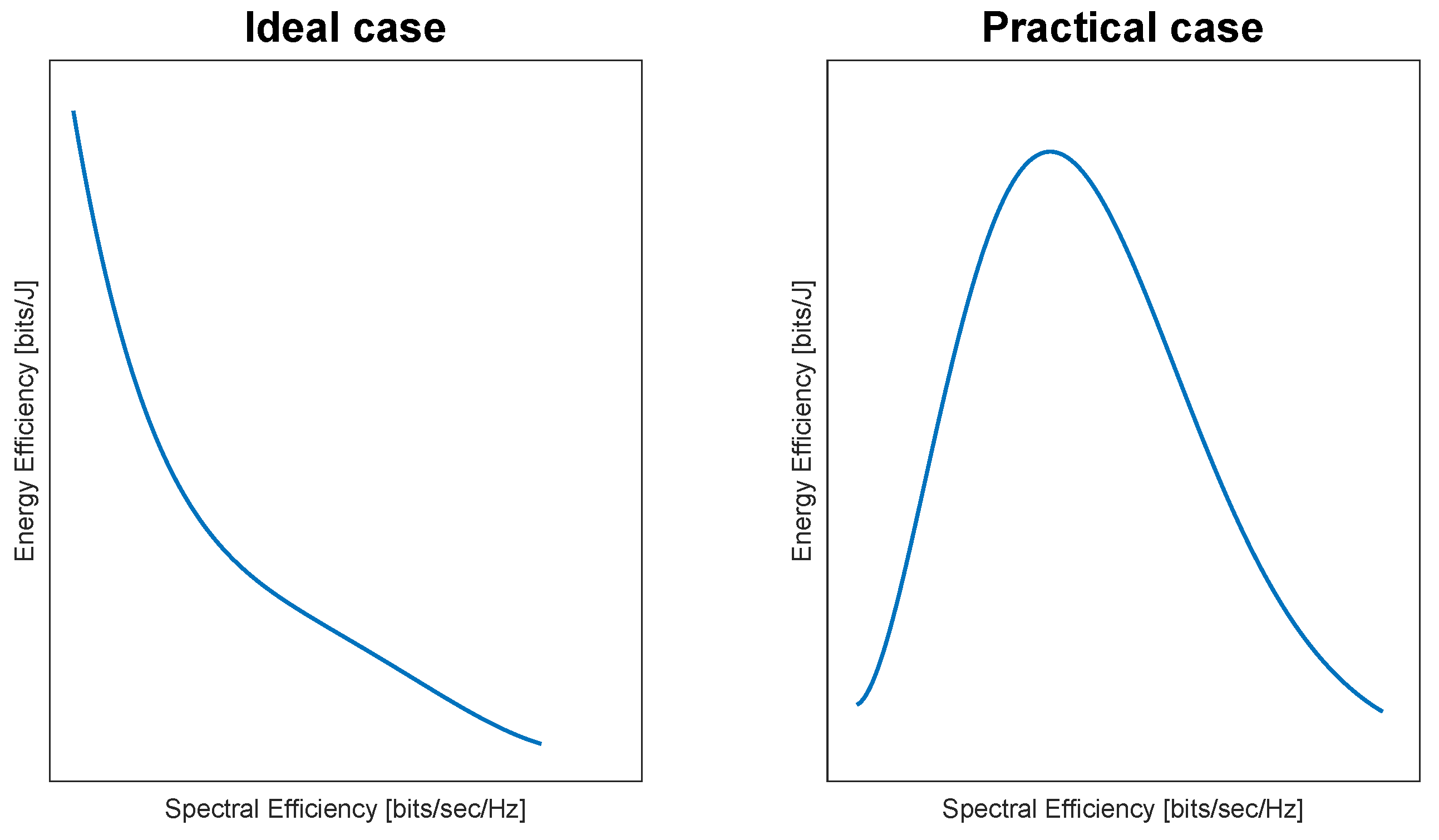
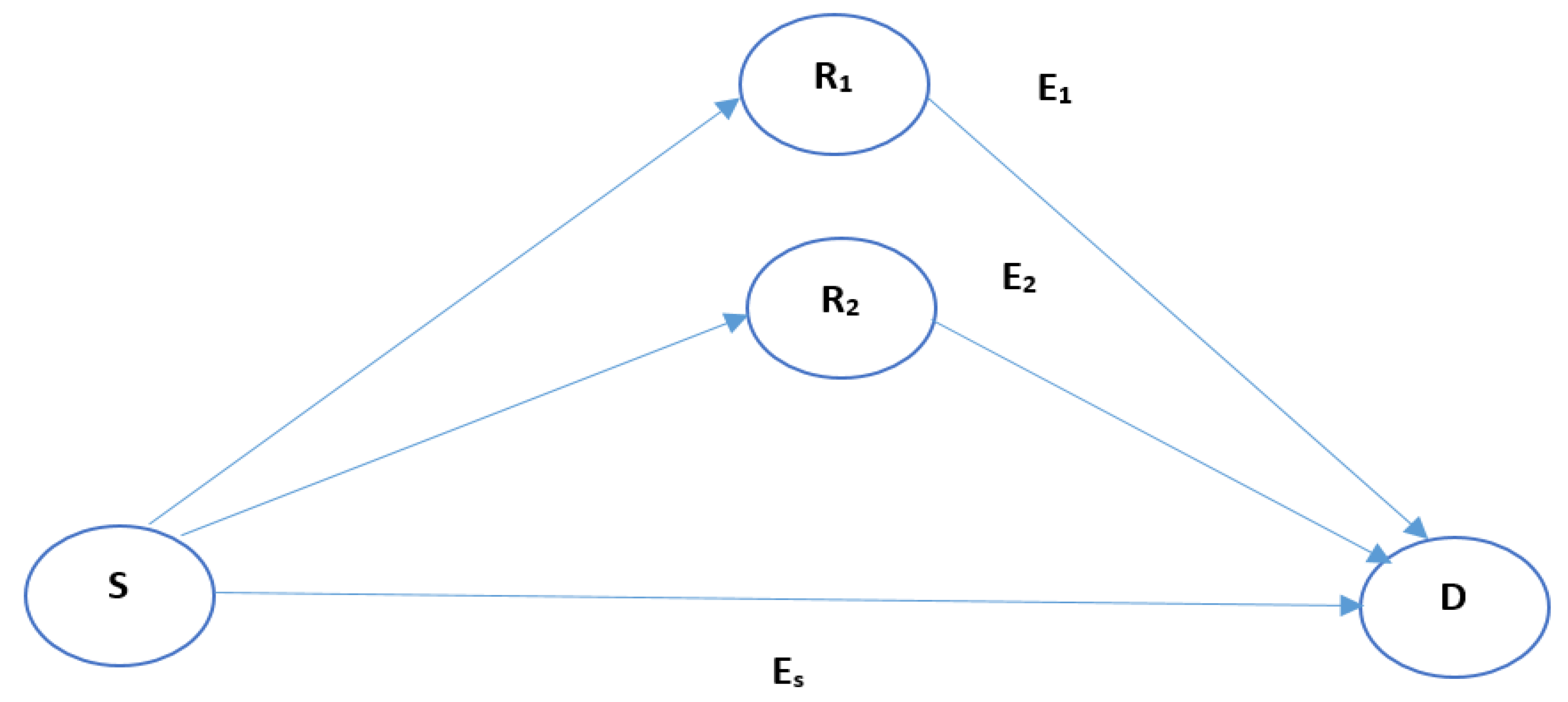
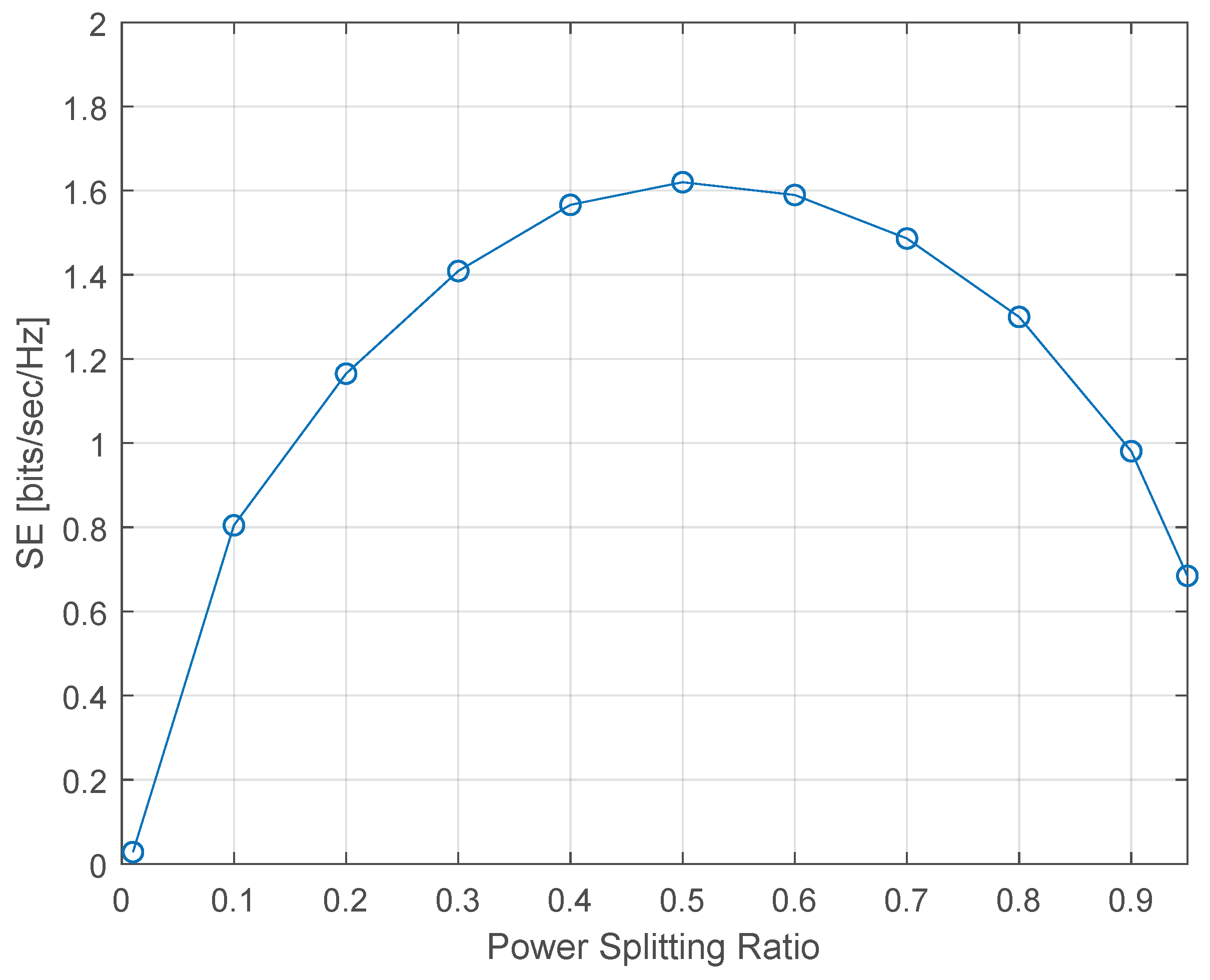
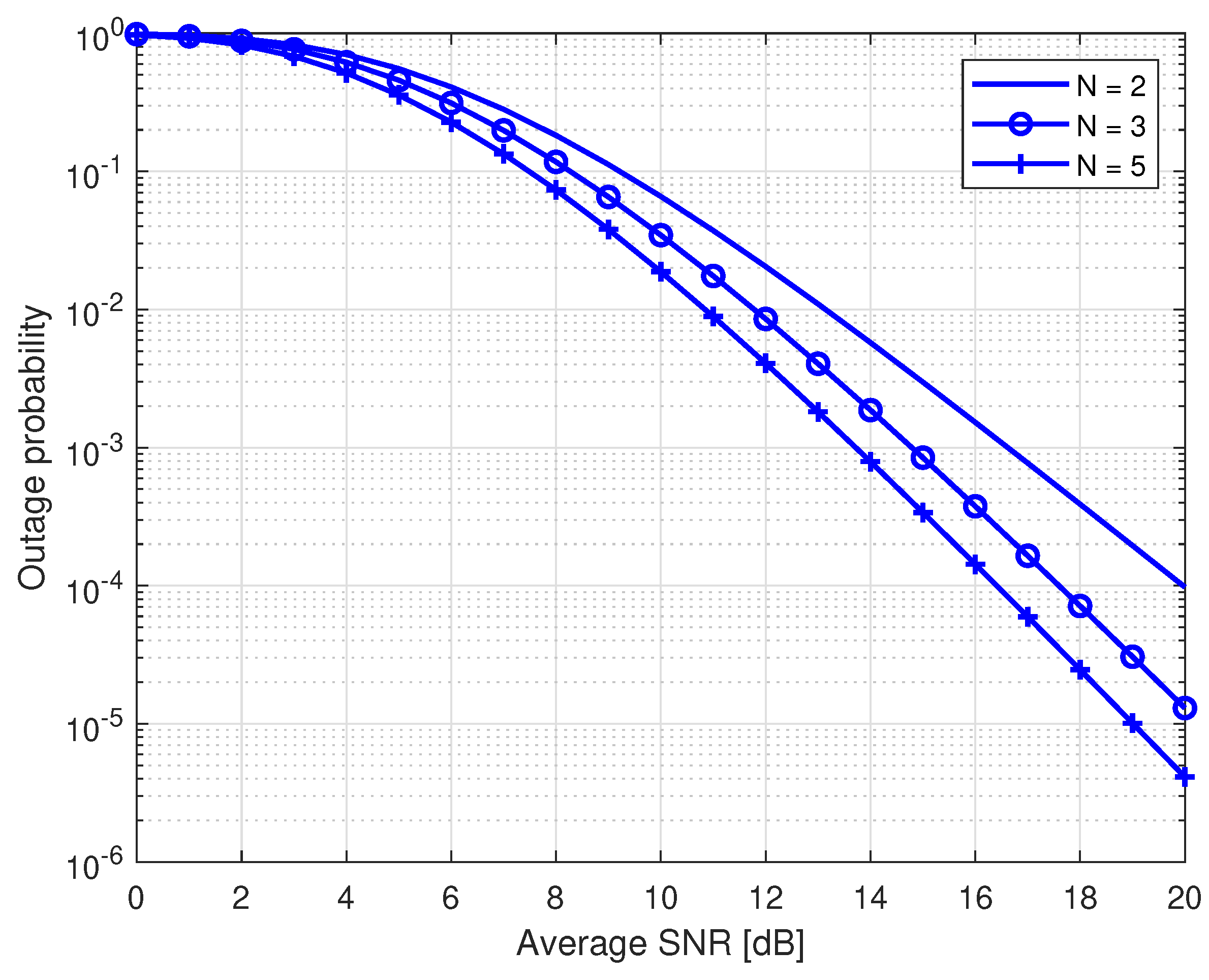
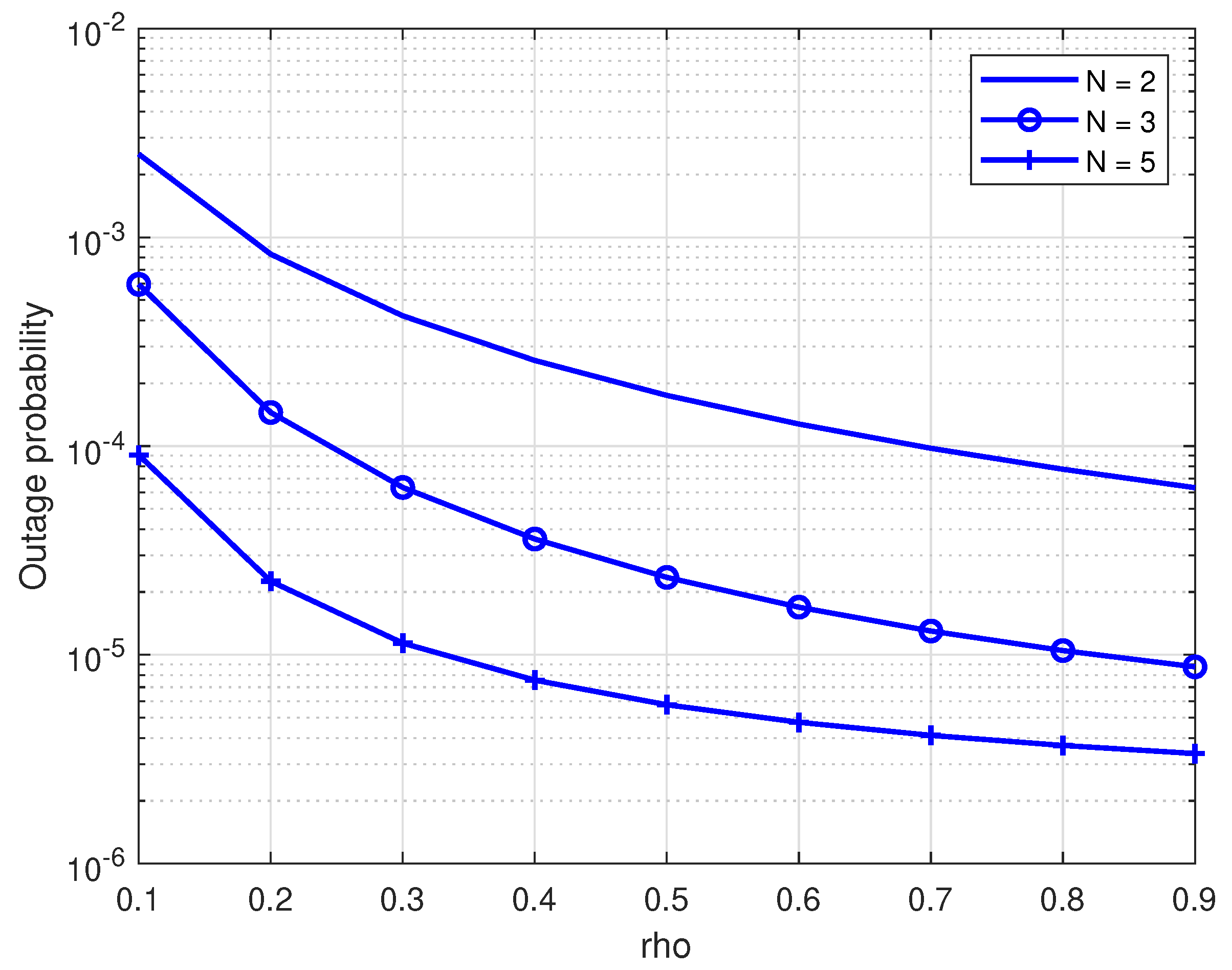
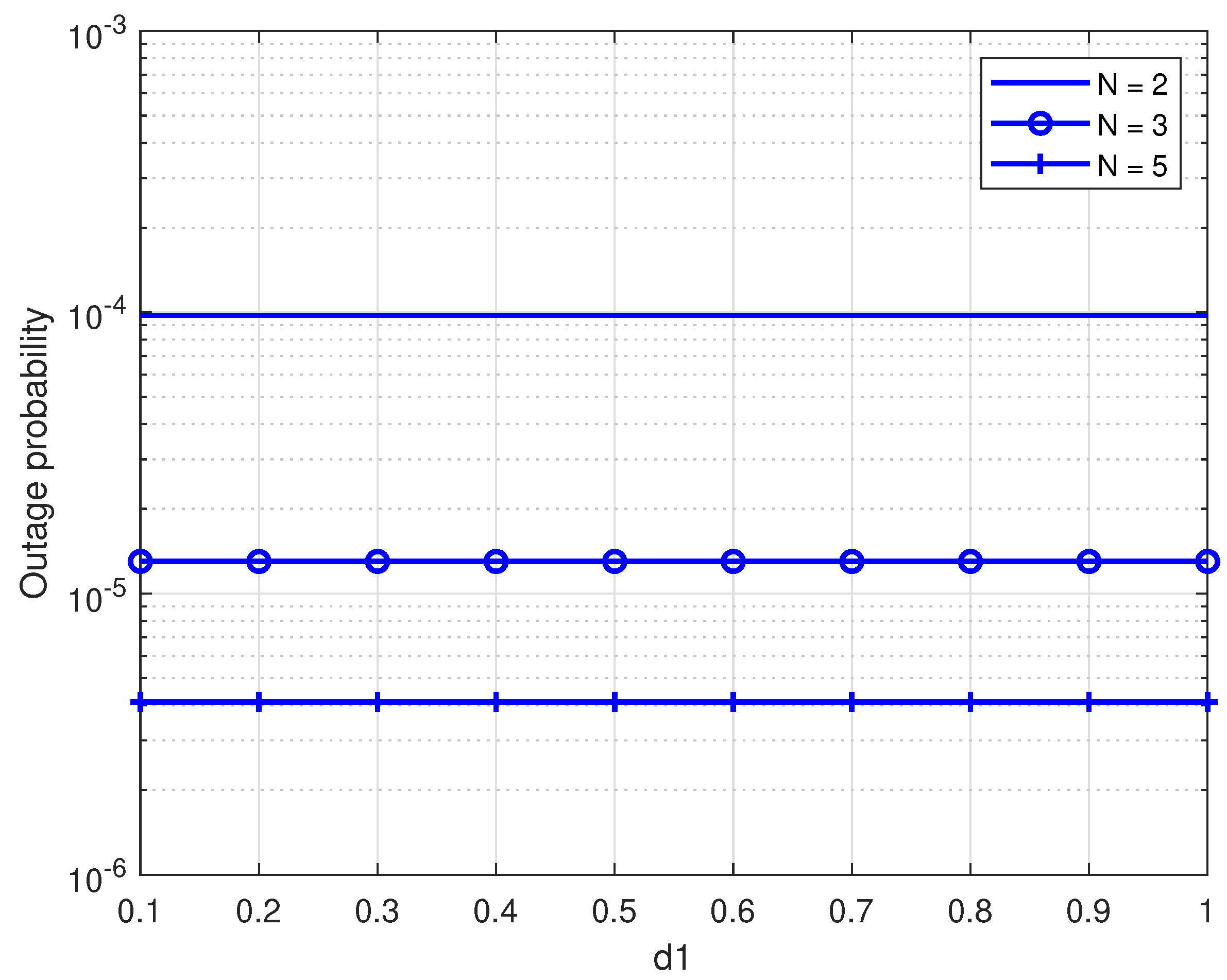

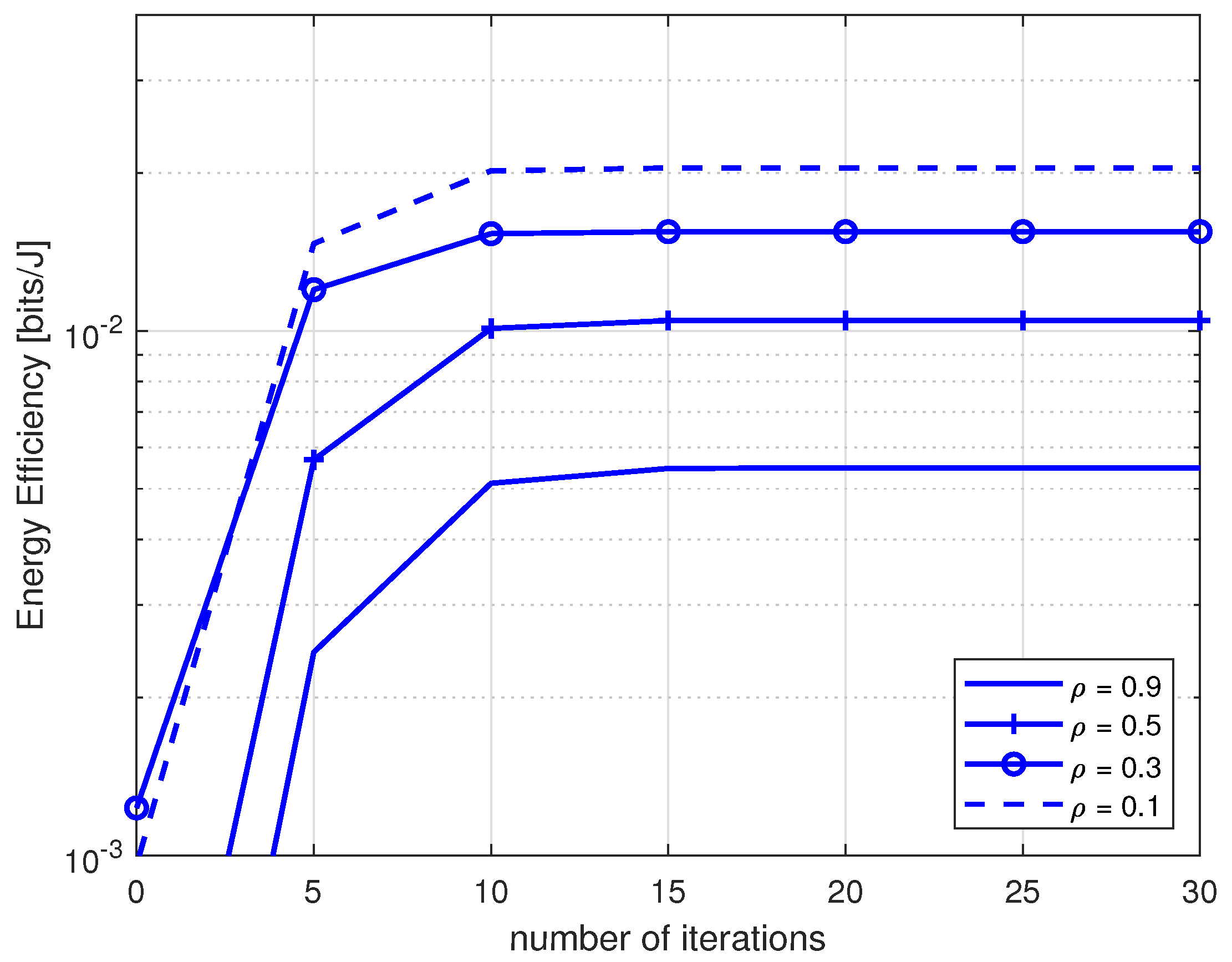
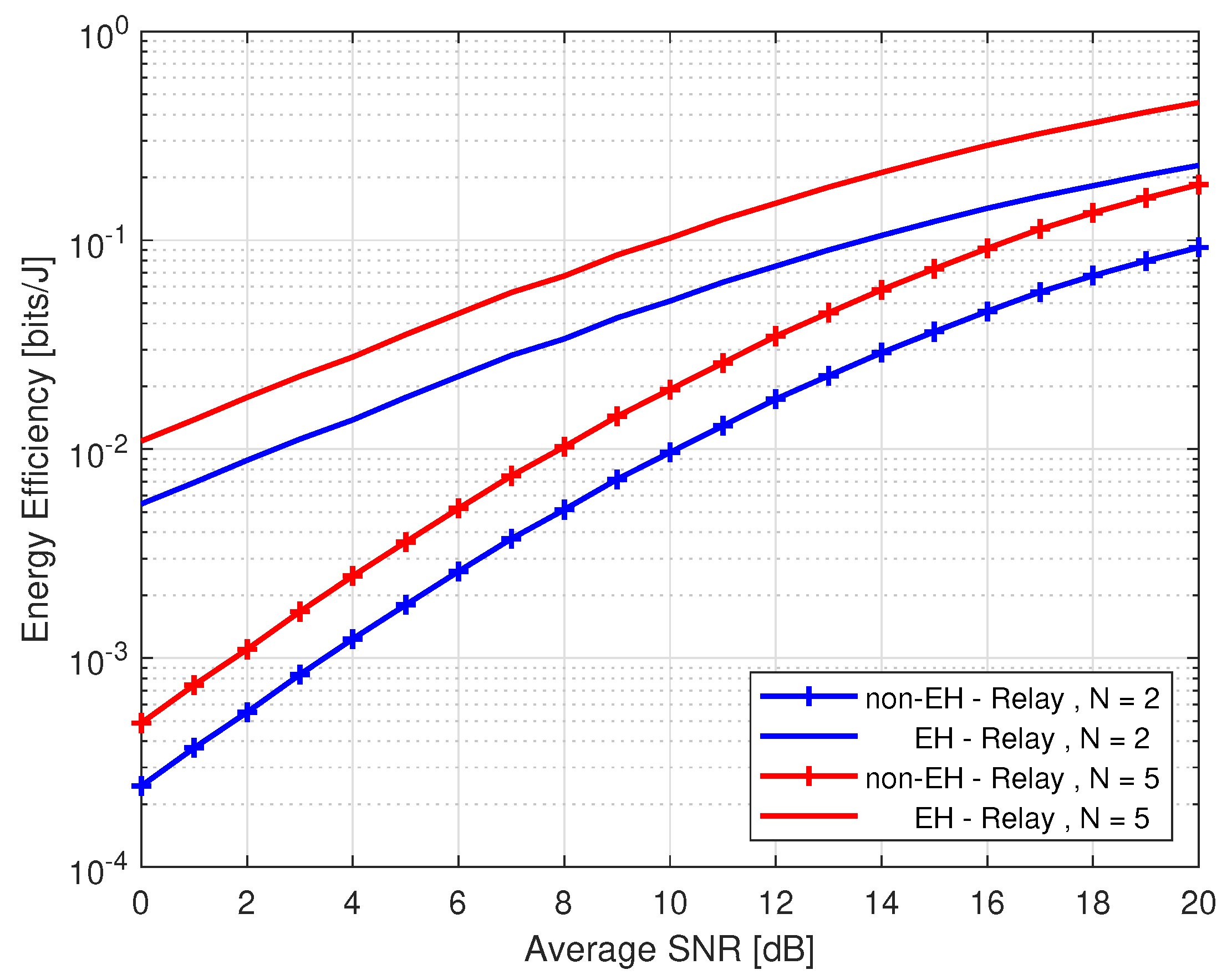
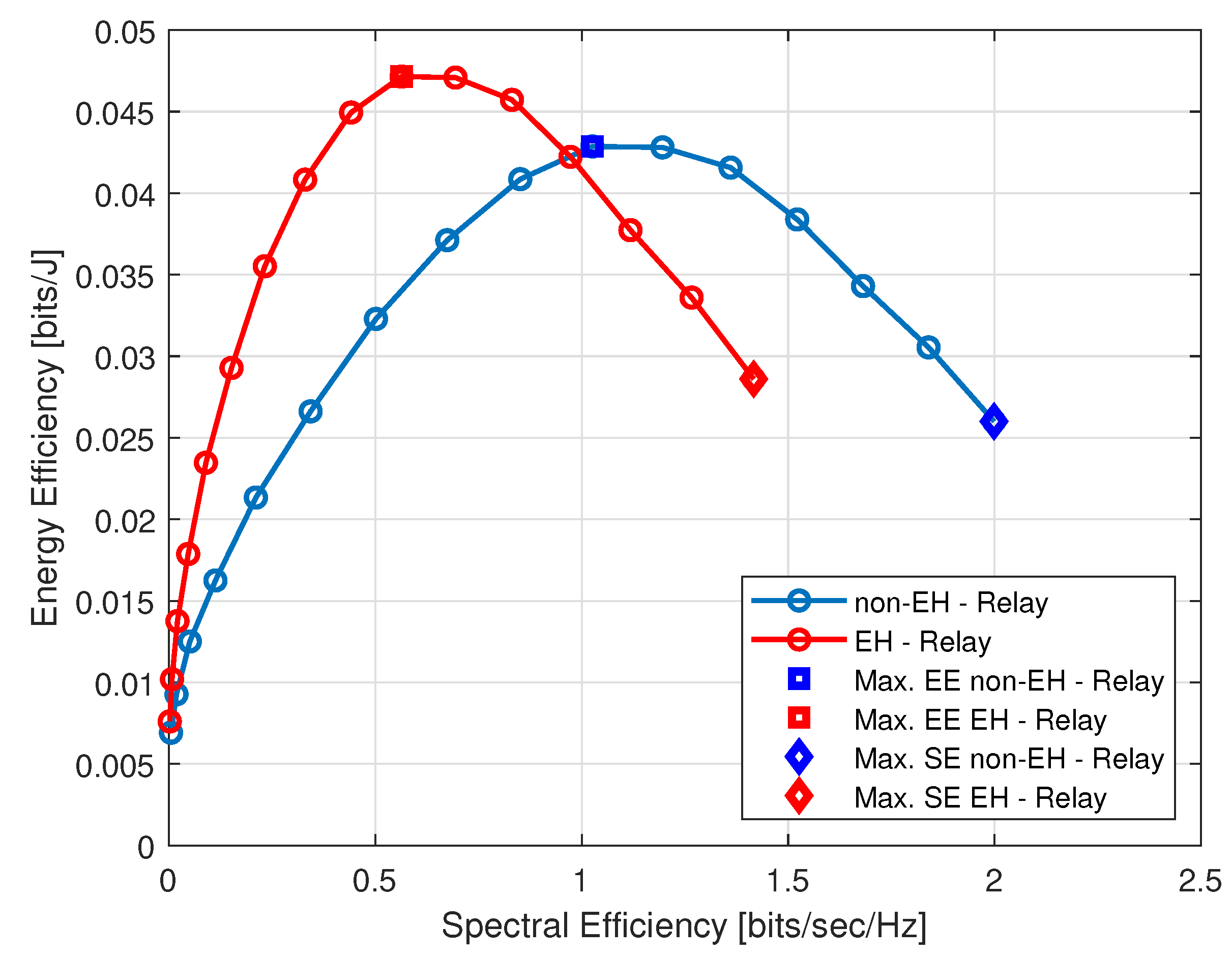
| Parameter | Value |
|---|---|
| SNR threshold | 5 dB |
| Energy conversion efficiency | 0.6 |
| Path loss exponent n | 2 |
| Normalized distance from S to relay i, | m |
| Normalized distanc from S to relay i, | m |
| Normalized distanc from S to D | 1 m |
| Maximum energy at the source | 3 J |
| Maximum energy at the selected relay | 3 J |
| Number of relays N | 2, 3, 5 |
| Bit error rate-target |
© 2019 by the authors. Licensee MDPI, Basel, Switzerland. This article is an open access article distributed under the terms and conditions of the Creative Commons Attribution (CC BY) license (http://creativecommons.org/licenses/by/4.0/).
Share and Cite
Andrawes, A.; Nordin, R.; Ismail, M. Wireless Energy Harvesting with Cooperative Relaying under the Best Relay Selection Scheme. Energies 2019, 12, 892. https://doi.org/10.3390/en12050892
Andrawes A, Nordin R, Ismail M. Wireless Energy Harvesting with Cooperative Relaying under the Best Relay Selection Scheme. Energies. 2019; 12(5):892. https://doi.org/10.3390/en12050892
Chicago/Turabian StyleAndrawes, Admoon, Rosdiadee Nordin, and Mahamod Ismail. 2019. "Wireless Energy Harvesting with Cooperative Relaying under the Best Relay Selection Scheme" Energies 12, no. 5: 892. https://doi.org/10.3390/en12050892
APA StyleAndrawes, A., Nordin, R., & Ismail, M. (2019). Wireless Energy Harvesting with Cooperative Relaying under the Best Relay Selection Scheme. Energies, 12(5), 892. https://doi.org/10.3390/en12050892






